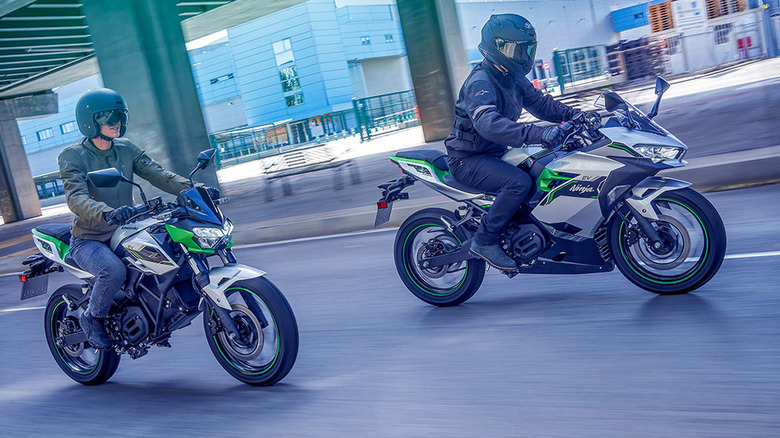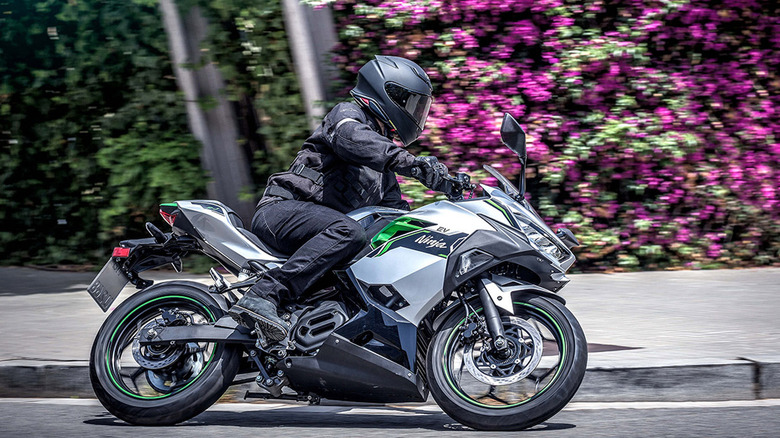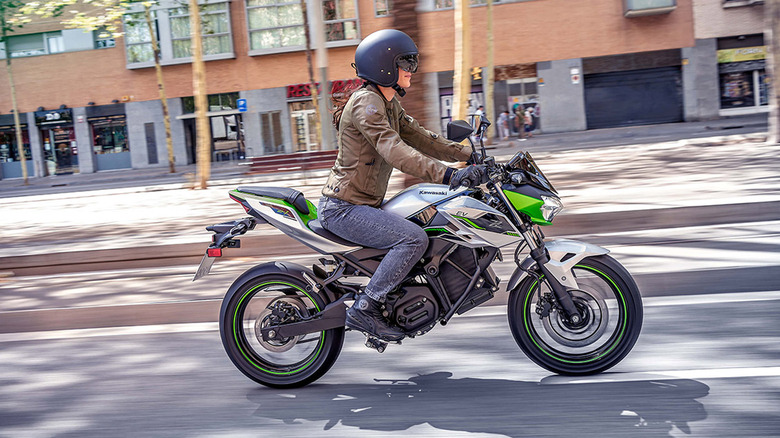Yes, Kawasaki Makes Electric Motorcycles: What To Know About The Ninja E-1 & Z E-1
As the push toward electric vehicles continues, it should come as no surprise to see the major motorcycle brands consider the move to electric too. Kawasaki, as a result, offers a pair of electric bikes in the Ninja e-1 and Z e-1. Neither bike has any emissions, and unlike some other EVs, these bikes aren't far more expensive than their competition. The MSRP for the Z e-1 and Ninja e-1 are $7,859 and $7,899 respectively, so you don't have to worry about breaking the bank if you're in the market for one. However, gas-powered Ninjas with better performance are priced lower — a Ninja 500 comes in at $5,299.
Kawasaki gives the pair of bikes the new rider-friendly branding, so they look to be decent options for beginners looking to ditch the gas. Typically, Kawasaki offers a 12-month warranty with new motorcycles, but both of these electric options see that bumped up to two years. With EVs still relatively new, it makes sense to see that type of protection to help sweeten the deal of purchasing one.
What's special about the Kawasaki Ninja e-1 and Z e-1?
The e-1 and Z e-1 weigh 308.7 and 297.7 lbs respectively. That difference in weight could go a long way toward making a beginner rider feel more comfortable on the road.
Of course, the biggest change of all from made from the Ninja 400 is running on electricity instead of gas. With EV charging networks adding new stations all the time, it's a good time to hop on an electric motorcycle and not have to worry about being stranded on the side of the road. Both the e-1 and Z e-1 have 41-mile ranges on their batteries according to Kawasaki, but charging is lengthy. The bikes are powered by two batteries, and each one takes 3.7 hours to fully charge up. In total, that's close to eight hours for a full charge.
These factors make distance riding more difficult than it would be on a regular bike. You won't want to pick one of these up if you plan on long touring trips unless you don't mind a lot downtime. The range make them good commuting bikes or for riding around cities.
How do the Kawasaki Ninja e-1 and Z e-1 perform?
Some of the fastest motorcycles Kawasaki ever built blow past the 200 mph mark, but that's not the case with these two electric options. In fact, they don't come close to hitting 100 mph, but they can reach a modest mid-60s depending on the mode. There are two modes — ECO and ROAD — to choose from for these motorcycles. The ROAD mode coupled with e-boost gets the e-1 to 65 mph and Z e-1 to 63 mph, according to Kawasaki. This, along with the range, makes them bikes that are best driven close to home.
Cycle World took test rides of each bike and reported they are comfortable to ride. The publication doesn't indicate any glaring issues outside of range and top speed. If you don't need either of those things, you'll be happy with these zero-emission options from Kawasaki. ECO mode is designed to give you more range on the battery, but Cycle World recommends staying in ROAD mode most of the time due to the better performance. If you want something that can help save on gas costs while keeping a respectable performance, you may want to consider the Ninja 7 Hybrid as an alternative.


